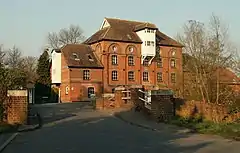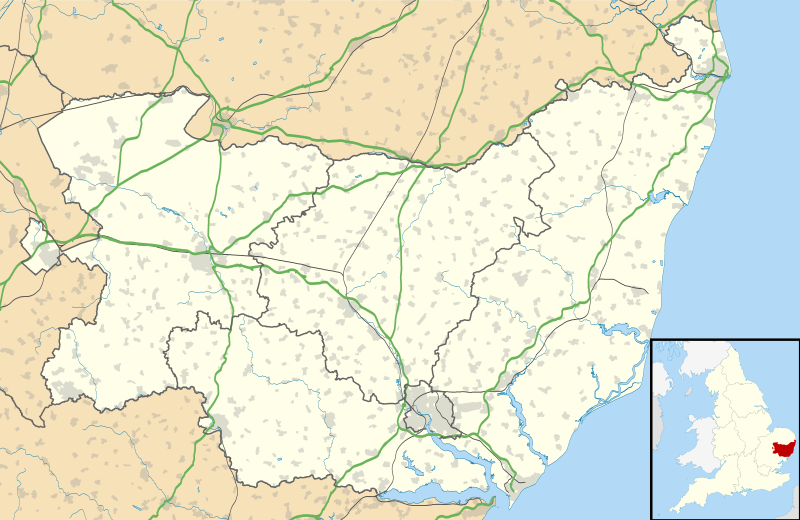Needham Market
Needham Market is a town in Suffolk, England. The town of Needham, Massachusetts, was named after Needham Market.[2]
| Needham Market | |
|---|---|
 Hawks Mill, Needham Market now converted into flats | |
 Needham Market Location within Suffolk | |
| Population | 4,528 (2011 Census)[1] |
| OS grid reference | TM090548 |
| District | |
| Shire county | |
| Region | |
| Country | England |
| Sovereign state | United Kingdom |
| Post town | IPSWICH |
| Postcode district | IP6 |
| Dialling code | 01449 |
| Police | Suffolk |
| Fire | Suffolk |
| Ambulance | East of England |
| UK Parliament | |
History
It initially grew around the wool combing industry, until the onset of the plague, which swept the town from 1663 to 1665. To prevent the spread of the disease, the town was chained at either end, which succeeded in its task but at the cost of two-thirds of the populace. The town did not recover for nearly two hundred years, with the canalisation of the River Gipping in the late 18th Century and the introduction of the railway. Modern Needham Market contains two road names that are linked to the plague. Chainhouse Road, named after the chains that ran across the East end of the town. The Causeway, is a modern variation of 'the corpseway' so called because of the route that plague victims were transported out of town, to neighbouring Barking church for interment.
Notable buildings
Notable buildings in the town include:
- The 15th-century parish church, the church of St. John the Baptist, originally a chapel of ease for the parish of Barking (with a unique double-hammerbeam roof).
- The mediaeval Limes Hotel
- The Stuart era school.
- Hawks Mill
- The Victorian railway station, built in 1849.
- no.12 High Street. A house now called The Waggon (after the Waggon and Horses Public House that once occupied), it was originally an Elizabethan construction of 1591: a 'black and white' design typical of the period, called The Old Hall.
- United Reform Church (now called Christchurch) was built in 1837.
- English architect, Frederick Barnes designed the Town Hall in 1866.
- The Almshouses are medieval (now called The Causeway).
- The Quaker Meeting House and its graveyard was constructed during the ages of enlightenment and revolution in 1772.
Sport and leisure
Needham Market has a Non-League football club Needham Market F.C. who play at Bloomfields, they have been very successful over recent years after reaching the semi-finals of the FA Vase.[3]
The town is on the route of the Dunwich Dynamo annual cycle ride.
Needham Lake (a former gravel pit) provides leisure facilities and a wildlife habitat.[4]
Transport
The East Anglia Main Line railway runs through the town, with Needham Market railway station providing trains to Ipswich and Cambridge. The A14 (although then the A45) once ran directly through Needham Market, but a bypass was built in the 1970s. This has left the town with good road links to the surrounding area, but with less traffic than before.
Notable people
Notable people from Needham include:
- Joseph Priestley (1733 – 1804), dissenter, who discovered oxygen.
- Dykes Alexander (1763 – 1849), Quaker businessman and minister.
- George Ewart Evans (1909 – 1988), author
- June Brown (born 1927), actress, who played Dot Cotton in EastEnders
- Ros Scott (born 1957), Liberal Democrat peer, a former district and county councillor for the town, chose it for her title.[5]
References
- "Town Population 2011". Neighbourhood Statistics. Office for National Statistics. Retrieved 25 August 2016.
- Rosenberg, Chaim M.; The Needham Historical Society (2012). Knitters of Needham. Arcadia. p. 17. ISBN 9780738591094.
- "Club History - Needham Market Football Club". Needhammarketfc.co.uk. Archived from the original on 8 October 2011. Retrieved 8 August 2012.
- "Needham Lake". Mid Suffolk District Council. Archived from the original on 6 April 2013. Retrieved 4 January 2013.
- "Baroness Scott of Needham Market | People". Libdems.org.uk. Retrieved 8 August 2012.